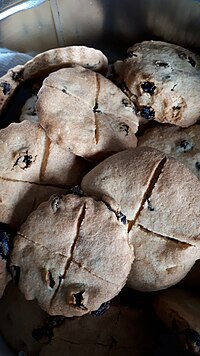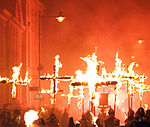English festivals
Most are observed throughout the country but some, such as Oak Apple Day, Souling, Rushbearing, Bawming the Thorn, and Hocktide, are local to certain regions.[2][3] In Allendale, the town's New Year celebrations involve lighted tar barrels that are carried on the heads of revellers called guisers.In 18th-century England, it evolved into an occasion in which lovers expressed their love for each other by presenting flowers, offering confectionery, and sending greeting cards (known as "valentines").In Norfolk, a character called 'Jack' Valentine knocks on the rear door of houses leaving sweets and presents for children.It is a festival and holiday celebrating the resurrection of Jesus from the dead, described in the New Testament as having occurred on the third day of his burial after his crucifixion by the Romans at Calvary c. 30 AD.In the north of England, the traditions of rolling decorated eggs down steep hills and pace egging are still adhered to today.John of Gaunt, the 1st Duke of Lancaster, granted grazing rights and permission to fish in the River Kennet to the commoners of Hungerford.Despite a legal battle during the reign of Elizabeth I (1558-1603) when the Duchy attempted to regain the lucrative fishing rights, the case was eventually settled in the townspeople's favour after the Queen herself interceded.The Hocktide Council, which is elected on the previous Friday, appoints two Tutti Men whose job it is to visit the properties attracting Commoner's Rights.Some newspapers, magazines and other published media report fake stories, which are usually explained the next day or below the news section in smaller letters.At the turn of the twentieth century, people in Herefordshire at Kingstone and Thruxton left "trays of moss outside their doors for the fairies to dance upon".It involves a pyramidal or conical wicker or wooden framework that is decorated with foliage being worn by a person as part of a procession, often accompanied by musicians.[42] Judge thought it unlikely that the Jack in the Green itself existed much before 1770, due to an absence of either the name or the structure itself in any of the written accounts of visual depictions of English May Day processions from before that year.[44] In his diary, Samuel Pepys recorded observing a London May Day parade in 1667 in which milk-maids had "garlands upon their pails" and were dancing behind a fiddler.In 1660, Parliament passed into law "An Act for a Perpetual Anniversary Thanksgiving on the Nine and Twentieth Day of May", declaring 29 May a public holiday "for keeping of a perpetual Anniversary, for a Day of Thanksgiving to God, for the great Blessing and Mercy he hath been graciously pleased to vouchsafe to the People of these Kingdoms, after their manifold and grievous Sufferings, in the Restoration of his Majesty..."[49] The public holiday was formally abolished in the Anniversary Days Observance Act 1859, however, events still take place at Upton-upon-Severn in Worcestershire, Marsh Gibbon in Buckinghamshire, Great Wishford in Wiltshire (when villagers gather wood in Grovely Wood), and Membury in Devon.The day is generally marked by re-enactment activities at Moseley Old Hall, West Midlands, one of the houses where Charles II hid in 1651.The festival was widespread in Britain from the Middle Ages and well established by the time of Shakespeare,[53] but had fallen into decline by the beginning of the 19th century, as church floors were flagged with stone.The loaf is blessed, and in Anglo-Saxon England,[59] lammas bread was broken into four bits, which were to be placed at the four corners of the barn, to protect the garnered grain.The term Halloween is derived from the phrase All Hallows Even which refers to the eve of the Christian festival of All Saint's held on 1 November.It begins the season of Allhallowtide,[64] the time in the liturgical year dedicated to remembering the dead, including saints (hallows), martyrs, and all the faithful departed.[65][66] Modern customs observed on Halloween have been influenced by American traditions and include trick or treating, wearing costumes and playing games.[74] Rogers (2003) believes Souling was traditionally practised in the counties of Yorkshire, Lancashire, Cheshire, Staffordshire, peak district of Derbyshire, Somerset and Herefordshire.[85] Similarly in Shropshire, during the late 19th century, "there was set upon the board at All Hallows Eve a high heap of Soul-cakes" for visitors to take.Its history begins with the events of 5 November 1605, when Guy Fawkes, a member of the Gunpowder Plot, was arrested while guarding explosives the plotters had placed beneath the House of Lords.Celebrating the fact that King James I had survived the attempt on his life, people lit bonfires around London; and months later, the introduction of the Observance of 5th November Act enforced an annual public day of thanksgiving for the plot's failure.The present-day Guy Fawkes Night is usually celebrated at large organised events, centre on a bonfire and extravagant firework displays.Modern observances include a gathering of blacksmiths at the National Trust's Finch Foundry in Sticklepath "where they practise their art and celebrate their patron saint, St Clement".The festival was known as Bite-Apple night in places such as Wednesbury (Sandwell) and Bilston (Wolverhampton)[93] when people went "Clementing" in a similar manner to Souling.Every year, Norway donates a giant Christmas tree for the British to raise in Trafalgar Square as a thank you for helping during the Second World War.Although now known as a Christmas gift-bringer, and normally considered to be synonymous with American culture's Santa Claus which is now known worldwide, he was originally part of an unrelated and much older English folkloric tradition.













Oak Apple DaySoulingAllendaleguiserssilver bandPlough MondayTwelfth Day (Epiphany)Plough SundayploughShrove TuesdaypancakesSaint Valentine's DayWestern Christianfeast daysaintsValentinusromanceMartyrdommartyrologieswrittenSaint Valentine of Romepersecuted under the Roman Empirelegendromantic loveGeoffrey Chaucercourtly loveloversconfectionerygreeting cardsheart-shapedSaint Valentine's KeysepilepsyAnglican CommunionLutheran ChurchEastern Orthodox Church6 July30 JulypresbyterHieromartyrNorfolkMother's DayUnited KingdomLaetare SundayEastercrucifixionresurrectionRabbula Gospelfestivalholidayresurrection of JesusNew Testamenthis crucifixionCalvaryPassion of JesusGreat Lentfastingpenancebank holidaysrolling decorated eggs down steep hillspace eggingHocktidemediaevalWhitsuntidetwelve daysChristmastideweek following EastervilleindemesneReformationQueen ElizabethKenilworthmassacre of the DanesSt. Brice's DayHarthacanuteHungerfordDuchy of LancasterJohn of GauntDuke of LancasterRiver KennetTown crierclovednosegaysApril Fools Daypractical jokeshoaxespublic holidaySaint George's DaySaint GeorgeDiocletianic PersecutionSalisburyBBC Radio 3Andrew RosindellConservativeRomfordHouse of CommonsBoris Johnsonmorris dancingPunch and JudySt George's CrossJerusalemTraditional English food and drinkMay DayOxfordcelebrationsMay Queenmaypolepagan Anglo-SaxonÞrimilci-mōnaþOld EnglishCelticpeopleJack in the GreenEnglishfolk customSamuel PepysThe TatlerThe SpectatorBristolKnutsfordDeptfordGreenwichBermondseyPagan PrideHolbornrestorationEnglish monarchy
